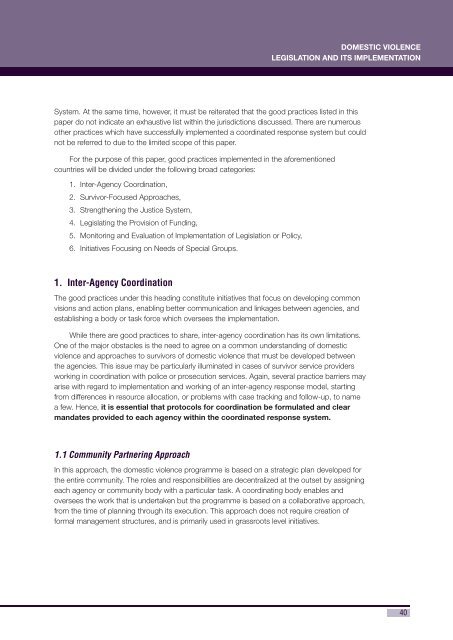Domestic Violence Legislation and its Implementation
Domestic Violence Legislation and its Implementation
Domestic Violence Legislation and its Implementation
Create successful ePaper yourself
Turn your PDF publications into a flip-book with our unique Google optimized e-Paper software.
DOMESTIC VIOLENCE<br />
LEGISLATION AND ITS IMPLEMENTATION<br />
System. At the same time, however, it must be reiterated that the good practices listed in this<br />
paper do not indicate an exhaustive list within the jurisdictions discussed. There are numerous<br />
other practices which have successfully implemented a coordinated response system but could<br />
not be referred to due to the limited scope of this paper.<br />
For the purpose of this paper, good practices implemented in the aforementioned<br />
countries will be divided under the following broad categories:<br />
1. Inter-Agency Coordination,<br />
2. Survivor-Focused Approaches,<br />
3. Strengthening the Justice System,<br />
4. Legislating the Provision of Funding,<br />
5. Monitoring <strong>and</strong> Evaluation of <strong>Implementation</strong> of <strong>Legislation</strong> or Policy,<br />
6. Initiatives Focusing on Needs of Special Groups.<br />
1. Inter-Agency Coordination<br />
The good practices under this heading constitute initiatives that focus on developing common<br />
visions <strong>and</strong> action plans, enabling better communication <strong>and</strong> linkages between agencies, <strong>and</strong><br />
establishing a body or task force which oversees the implementation.<br />
While there are good practices to share, inter-agency coordination has <strong>its</strong> own limitations.<br />
One of the major obstacles is the need to agree on a common underst<strong>and</strong>ing of domestic<br />
violence <strong>and</strong> approaches to survivors of domestic violence that must be developed between<br />
the agencies. This issue may be particularly illuminated in cases of survivor service providers<br />
working in coordination with police or prosecution services. Again, several practice barriers may<br />
arise with regard to implementation <strong>and</strong> working of an inter-agency response model, starting<br />
from differences in resource allocation, or problems with case tracking <strong>and</strong> follow-up, to name<br />
a few. Hence, it is essential that protocols for coordination be formulated <strong>and</strong> clear<br />
m<strong>and</strong>ates provided to each agency within the coordinated response system.<br />
1.1 Community Partnering Approach<br />
In this approach, the domestic violence programme is based on a strategic plan developed for<br />
the entire community. The roles <strong>and</strong> responsibilities are decentralized at the outset by assigning<br />
each agency or community body with a particular task. A coordinating body enables <strong>and</strong><br />
oversees the work that is undertaken but the programme is based on a collaborative approach,<br />
from the time of planning through <strong>its</strong> execution. This approach does not require creation of<br />
formal management structures, <strong>and</strong> is primarily used in grassroots level initiatives.<br />
40

















